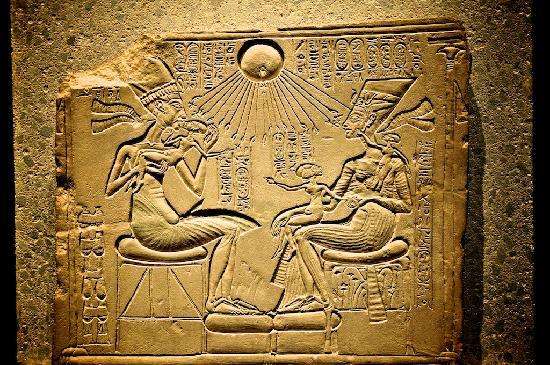THE ANCIENT WORLD FASHION ICON
Queen Nefertiti
The Egyptian Queen Nefertiti -- whose name translates as "a beautiful woman has come" -- is famed for possessing both political influence and great beauty.
She was the wife of Akhenaten (named after his worship of the sun disk, Aten), who reigned over 18th-dynasty Ancient Egypt in the 14th century BCE, during the New Kingdom era, and created a glittering city at Amarna.
Nefertiti's allure is heightened by mystery -- she seems to have disappeared without trace and theories abound about her fate.
Dressing a goddess
Contemporary statues and reliefs depict a woman with a striking face, and some show a curvaceous form highlighted by clinging garments.
Such images would have been idealized according to the era's spiritual values.
Nefertiti (along with her six daughters) would have constituted a living fertility goddess, emphasized by those images that portray her as wide hipped or in tight clothes;
surviving evidence suggests that contemporary garments were in fact looser than depicted.
Nefertiti's clothing trademarks include a distinctive tall, straight-sided and flat-topped crown worn exclusively by her (left).
Her garments were in the fine, pleated linen worn by New Kingdom royals and often depicted as being so fine that it became transparent - an aid to showing off the divine body.
The linen was probably thicker in reality.
Image of Nefetiti show how Egyptian linen lent itself to draping, folding, and well-defined pleating.
Ancient Egyptian styles remained similar for centuries, but during the 18th dynasty in which Nefertiti lived, a more complex draping of larger pieces of fabric developed (alongside the basic kalasaris sheath).
Nefertiti is depicted wearing long, fine tunics draped in ways typical of New Kingdom times.
Frequently the material's gathering appears to center on one point, often close to the bust, creating a distinctive high-waisted shape;
she appears with and without sleeves.
A famous painted limestone statue of the royal couple, hand in hand, from around 1340BCE, shows Nefertiti in a long, pleated linen tunic (often called a haik), caught between the waist and bust, gathered to produce undefined sleeves, and clinging especially closely to the lower body.
Since dyeing linen is difficult and it was the staple fiber, Egyptian clothing tends to be white.
Rich color was added with accessories by most levels of society.
An icon for the modern age
More than 3,500 years have elapsed yet Nefertiti and all things Egyptian continue to insprie today's designers.
The seminal blue-crowned bust (FAR LEFT) was unearthed in 1912 and made its way to Berlin's Egyptian Museum, where it remains.
Upon its Berlin unveiiling, in 1923, this arresting image had an immediate impact on the public, cementing a fascination for all things Egyptian that had been fired the year before by the discovery of the tomb of boy-pharaoh Tutankhamun.
"Egyptomania" gripped fashion design of the Art Deco era, from scarab jewelry to flowing, draped dresses, exotic embroidery, pyramid and lotus-flower motifs, dramatic deep headbands, and a love of Nile-green and bright blues.
There was even a mummy wrap dress in the 1920s, an idea interpreted afresh in the skintight bandage dresses of the 2000s.
Flappers' love of dark hair, red lips, and darkly outlined eyes was part of Egyptomania, and would most likely have been encouraged by Nefertiti's famed bust.
--《The definitive history of costume and style》
时尚大拿奈费尔提蒂
埃及王后奈费尔提蒂 -- 名字的意思就是“一位美人走来了“ -- 她是古埃及历史上著名的兼具绝世美貌与权利地位的野心家。
她是奥克亨拿坦法老(以他们崇拜的太阳神Aken给自己命名的法老)的妻子,是公元前十四世纪古埃及第18个王朝的共同统治者,他们建立了一个新的王朝和一座耀眼的城市阿玛那。
奈费尔提蒂的魅力在于她是一个难以解开的谜 -- 她似乎某一天突然消失历史上没有留下任何与她身世有关的记载。
女神服饰
那个时期的雕像和浮雕向我们展示埃及女性精致的脸庞,还有在紧身衣包裹下的美丽曲线。
这些画面根据当时的时代精神被刻意理想化了。
奈费尔提蒂(和她的六个女儿)被生动地描绘成了生育女神的样子,这些图像着重强调他们宽大的臀部或者紧身的线条。
现存的证据告诉我们,当时真正的服装实际上比描绘的要宽松得多。
奈费尔提蒂的服饰标志,是一顶独特的高的,两侧直边顶部平整的皇冠。
她的服装是由专为新王国皇室所特制的精细压褶亚麻制成的,这些亚麻布服装质非常精细,以至于后来在很多作品中人们刻意将它描绘得轻薄如同透明,用来显示法老尊贵神圣的身体。
而真实的亚麻会更厚些。
奈费尔提蒂向我们展示了埃及人服装的裁剪状态,折叠方式和轮廓清晰的褶皱。
古古埃及风格沿袭了数百年,但在奈费尔提蒂的第十八代王朝中,一个更复杂利用更大片面料悬挂制成的款式出现了。
纳费尔提蒂式的精细长袍是新王朝时代最典型的着装。
常见的做法是将面料聚拢在中间一个点上,靠近胸部,从而创造处一个独特的高腰款式;
她的服装一边有袖一边无袖。
有一副著名的皇室夫妇石灰岩雕像,手牵着手,大约公元前1340年,展示了奈费尔提蒂穿着打褶的亚麻长袍(通常称它Haik),观察腰部和胸部的细节,我们可以看到被聚拢的面料盖过手臂成为袖子,而下半身是被刻画的非常紧身的。
由于亚麻染色的困难,而它又是当时主产的纤维,所以埃及的服装通常都是白的。
丰富的颜色被添加到了配饰上,这也代表了当时社会的最高层级。
现代偶像
3500年过去了,奈费尔提蒂和埃及人的一切依旧启发着当今的设计师们。
开创性的蓝色皇冠半身像于1912年出土,之后被送到柏林埃及博物馆,保存了下来。
直到1923年,这尊半身像被揭幕,醒目的视觉冲击立刻影响了所有人,这种凝结了对古埃及万物的迷恋一直持续到少年法老图坦卡蒙的陵墓被发现。
“egyptomania"埃及复兴抓住了装饰艺术时代的时尚设计,从圣甲虫珠宝,垂褶连身裙,异国刺绣,金字塔和莲花图案,戏剧化的头带,以及对尼罗河绿还有亮蓝色的爱。
甚至一个1920年出现了木乃包裹裙,到了本世纪初又被重新诠释成一种新的紧身绑带礼服裙。
时髦女郎们喜欢”egyptomania"埃及复兴里的黑色头发,红色嘴唇,描黑的眼线,并且这种喜爱最大的可能是受到奈费尔提蒂的半身像影响。




